汉英笔译基础教程第1章 翻译原则[精]
- 格式:ppt
- 大小:1.16 MB
- 文档页数:43

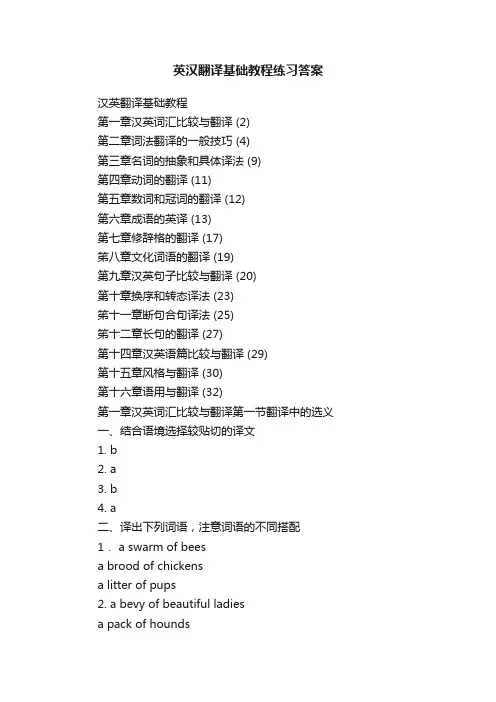
英汉翻译基础教程练习答案汉英翻译基础教程第一章汉英词汇比较与翻译 (2)第二章词法翻译的一般技巧 (4)第三章名词的抽象和具体译法 (9)第四章动词的翻译 (11)第五章数词和冠词的翻译 (12)第六章成语的英译 (13)第七章修辞格的翻译 (17)笫八章文化词语的翻译 (19)第九章汉英句子比较与翻译 (20)第十章换序和转态译法 (23)笫十一章断句合句译法 (25)笫十二章长句的翻译 (27)第十四章汉英语篇比较与翻译 (29)第十五章风格与翻译 (30)第十六章语用与翻译 (32)第一章汉英词汇比较与翻译第一节翻译中的选义一、结合语境选择较贴切的译文1. b2. a3. b4. a二、译出下列词语,注意词语的不同搭配1. a swarm of beesa brood of chickensa litter of pups2. a bevy of beautiful ladiesa pack of houndsa team of ducksa herd of antelopes3. unfailing supportproactive fiscal policymake effective use of overseas resources4. make a phone calltake a taxiknit a woolen sweaterfetch waterplay basketballspray insecticide5. basic wagecapital constructionessential commodityprimary industryfundamental interest三、翻译下列句子,注意画线词语的理解1. The two leaders exchanged views on bilateral relations and issues of common concern2. Party members should listen carefully to the opinions of the general public.3. They offered some suggestions for the revision of the plan.4. Everyone complained against such a practice.5. They had a dispute at the meeting.6. You should follow the doctor's advice.7. They reached a consensus on this issue.8. There is still some unfinished business to settle.9. We have consulted him about the matter.10. Please go back. There is nothing of your concern now第二节翻译中的选词一、翻译下列各句,注意词的选择和搭配。
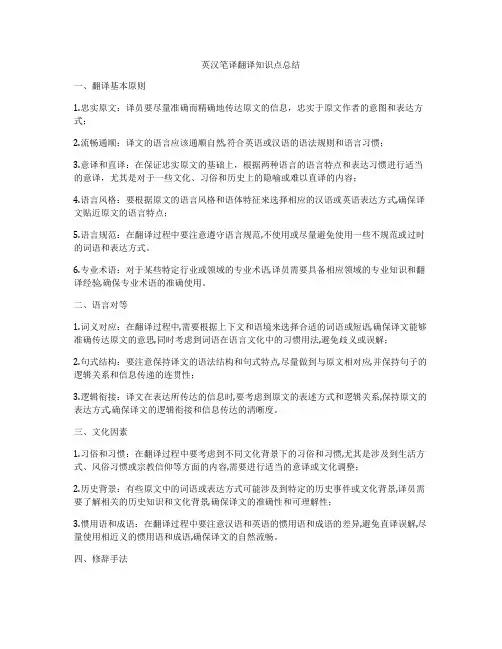
英汉笔译翻译知识点总结一、翻译基本原则1.忠实原文:译员要尽量准确而精确地传达原文的信息,忠实于原文作者的意图和表达方式;2.流畅通顺:译文的语言应该通顺自然,符合英语或汉语的语法规则和语言习惯;3.意译和直译:在保证忠实原文的基础上,根据两种语言的语言特点和表达习惯进行适当的意译,尤其是对于一些文化、习俗和历史上的隐喻或难以直译的内容;4.语言风格:要根据原文的语言风格和语体特征来选择相应的汉语或英语表达方式,确保译文贴近原文的语言特点;5.语言规范:在翻译过程中要注意遵守语言规范,不使用或尽量避免使用一些不规范或过时的词语和表达方式。
6.专业术语:对于某些特定行业或领域的专业术语,译员需要具备相应领域的专业知识和翻译经验,确保专业术语的准确使用。
二、语言对等1.词义对应:在翻译过程中,需要根据上下文和语境来选择合适的词语或短语,确保译文能够准确传达原文的意思,同时考虑到词语在语言文化中的习惯用法,避免歧义或误解;2.句式结构:要注意保持译文的语法结构和句式特点,尽量做到与原文相对应,并保持句子的逻辑关系和信息传递的连贯性;3.逻辑衔接:译文在表达所传达的信息时,要考虑到原文的表述方式和逻辑关系,保持原文的表达方式,确保译文的逻辑衔接和信息传达的清晰度。
三、文化因素1.习俗和习惯:在翻译过程中要考虑到不同文化背景下的习俗和习惯,尤其是涉及到生活方式、风俗习惯或宗教信仰等方面的内容,需要进行适当的意译或文化调整;2.历史背景:有些原文中的词语或表达方式可能涉及到特定的历史事件或文化背景,译员需要了解相关的历史知识和文化背景,确保译文的准确性和可理解性;3.惯用语和成语:在翻译过程中要注意汉语和英语的惯用语和成语的差异,避免直译误解,尽量使用相近义的惯用语和成语,确保译文的自然流畅。
四、修辞手法1.隐喻和比喻:在翻译中,对于原文中的隐喻和比喻,译员需要根据上下文和语境进行合适的意译,确保译文能够传达原文作者的表达意图和情感色彩;2.排比和对仗:在翻译文学作品时,需要注意原文中的排比和对仗等修辞手法,选择相应的汉语或英语表达方式,保持原文的格调和艺术效果;3.修辞疑问:译员需要充分理解原文的修辞手法和表达方式,并在译文中保留相应的修辞特色,确保译文的艺术性和表现力。
![汉英笔译基础教程 翻译技巧及真题[精]](https://uimg.taocdn.com/23818479f18583d04864591b.webp)

![汉英翻译技巧第1章 翻译标准[精]](https://uimg.taocdn.com/8c6ed839f01dc281e43af025.webp)
![汉英笔译基础教程第1章 翻译原则[精]](https://uimg.taocdn.com/7b18a85b83c4bb4cf6ecd11a.webp)
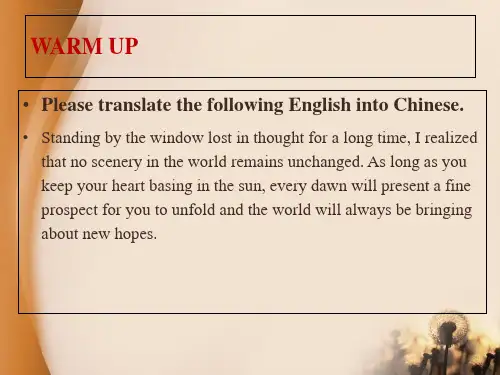
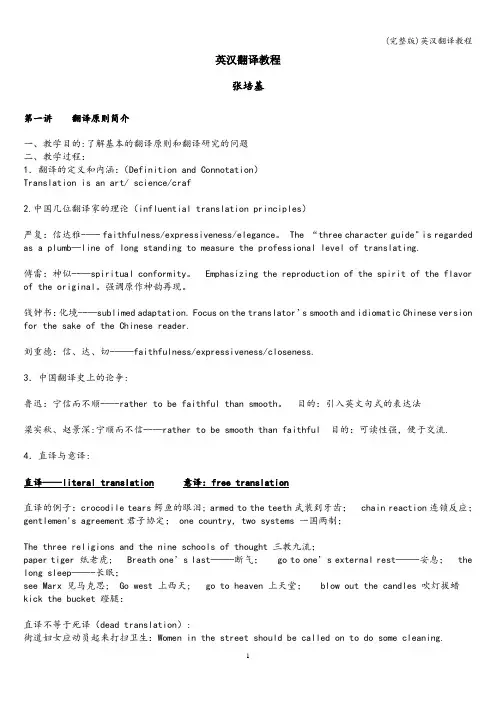
英汉翻译教程张培基第一讲翻译原则简介一、教学目的:了解基本的翻译原则和翻译研究的问题二、教学过程:1.翻译的定义和内涵:(Definition and Connotation)Translation is an art/ science/craf2.中国几位翻译家的理论(influential translation principles)严复:信达雅-—- faithfulness/expressiveness/elegance。
The “three character guide" is regarded as a plumb—line of long standing to measure the professional level of translating.傅雷:神似--—spiritual conformity。
Emphasizing the reproduction of the spirit of the flavor of the original。
强调原作神韵再现。
钱钟书:化境--—sublimed adaptation. Focus on the translator’s smooth and idiomatic Chinese version for the sake of the Chinese reader.刘重德:信、达、切-——faithfulness/expressiveness/closeness.3.中国翻译史上的论争:鲁迅:宁信而不顺-—-rather to be faithful than smooth。
目的:引入英文句式的表达法梁实秋、赵景深:宁顺而不信--—rather to be smooth than faithful 目的:可读性强,便于交流.4.直译与意译:直译—--literal translation意译:free translation直译的例子:crocodile tears鳄鱼的眼泪; armed to the teeth武装到牙齿; chain reaction连锁反应;gentlemen's agreement君子协定; one country, two systems 一国两制;The three religions and the nine schools of thought 三教九流;paper tiger 纸老虎; Breath one’s last——-断气; go to one’s external rest——-安息; the long sleep——-长眠;see Marx 见马克思; Go west 上西天; go to heaven 上天堂; blow out the candles 吹灯拔蜡kick the bucket 蹬腿:直译不等于死译(dead translation):街道妇女应动员起来打扫卫生:Women in the street should be called on to do some cleaning.“In the street" should be replaced by “in the community”.她一大早起床,进城,见到了她的公爹:She got up early, went to the town and saw her public father。
![unit1principlesoftranslation翻译原则[教学]](https://uimg.taocdn.com/a643573a7275a417866fb84ae45c3b3567ecdddc.webp)
A TestAll's Well That Ends WellIt was fine and warm one afternoon, and Will decided to go for a bicycle ride in the country. He was enjoy the sunshine and the peaceful roads, and when he came to a steep hill he let his bicycle run down it much too fast. But there was a sharp bend at the bottom of the hill. When he was nearly there, a dog rushed out of a farmyard, barking and jumping up at him.Will put his brakes on. He managed not to hit the dog, but he was going too fast to ger round the bend safely. The bicycle ran across the road and hit the bank at the other side. Fortunately, no vehicle was passing, so there was no danger of a collision. As Will was picking himself up, the farmer came out. When he saw that there was no damage, he brought Will back to the farmhouse and gave him a glass of fresh milk.Will was soon to go on with his ride. "All's well that ends well," he said to the farmer when they wished each other goodbye.My Version:结果好便一切都好在一个晴朗而温暖的午后,威尔决定在乡下骑车转转。
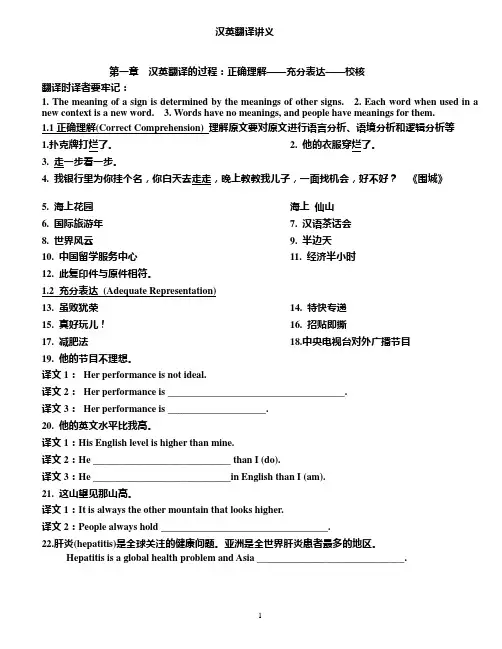
汉英翻译讲义第一章汉英翻译的过程:正确理解——充分表达——校核翻译时译者要牢记:1. The meaning of a sign is determined by the meanings of other signs.2. Each word when used in a new context is a new word.3. Words have no meanings, and people have meanings for them.1.1正确理解(Correct Comprehension) 理解原文要对原文进行语言分析、语境分析和逻辑分析等1.扑克牌打烂了。
2. 他的衣服穿烂了。
3. 走一步看一步。
4. 我银行里为你挂个名,你白天去走走,晚上教教我儿子,一面找机会,好不好?《围城》5. 海上花园海上仙山6. 国际旅游年7. 汉语茶话会8. 世界风云9. 半边天10. 中国留学服务中心11. 经济半小时12. 此复印件与原件相符。
1.2 充分表达(Adequate Representation)13. 虽败犹荣14. 特快专递15. 真好玩儿!16. 招贴即撕17. 减肥法18.中央电视台对外广播节目19. 他的节目不理想。
译文1:Her performance is not ideal.译文2:Her performance is ____________________________________.译文3:Her performance is ____________________.20. 他的英文水平比我高。
译文1:His English level is higher than mine.译文2:He ____________________________ than I (do).译文3:He ____________________________in English than I (am).21. 这山望见那山高。
第一章一、概述1.(1)英语:是语法型,重语法结构,注重以形显意,靠关联词,用显性连接(2)汉语:是语义型,重语义结构,通过逻辑纽带或语序间接地表现出来,隐形连接。
2.英语的形式接应手段:除关系代词、关系副词、连接代词、连接副词之外,还有若干连词和为数众多的介词。
英语的句子通常均有各种关联词来表示多种语法关系。
3.翻译特点(意合与形合):(1)英语译为汉语:形合转为意合类似松绑(注意汉语意合表现力、句法特点)(2)汉语译为英语:意合转为形合类似(注意符合英语句法结构),要求上下文中语义搭配合乎事理,强调的是语言结构内部意义关系的“意合”,即造句注重意念连贯,具体表现是关联词的大量省略,很多成分也经常隐去。
4.关于形合与意合的说明:虽然英语和汉语句法中有形合与意合的特征以及两者相互转换的必要,但不能由此推断英语中的形合结构必须一律转换为汉语的意合,或汉语的意合一律转成英语的形合。
因为每一种语言都有自身的伸缩性,形合与意合两种句法在英语和汉语中同样是存在的,只是在汉语中意合更为普遍,而英语中形合更为普遍。
二、例句1.形合到意合的转换:(1)I may be wrong and you may be right,and by an effort ,we may be nearer to the truth.也许我是错的,你是对的。
我们做出努力,就会更接近真理。
(2)Now there is in America a curious combination of pride in having risen to a position where it is no longer necessary to depend on manual labor for a living and genius delight in what one is able to accomplish with one’s own hands.现在美国有一个奇特的现象:一方面人们为上升到不在需要靠体力劳动谋生的地位而感到自豪,而另一方面却又对能用自己的双手做成一件事情而感到由衷的高兴。
《英汉翻译教程》第一章 总论 翻译是运用一种语言把另一种语言所表达的思维内容准确完整地重新表达出来的语言翻译应当把原文的本意,完全正确的介绍给中国读者,使中国读者得到的概念等于英俄日德法等国的读奈达认为更准确地反映出好的翻译的实际过程是:(1)分析:从语法和语义两方面对原文的信息进行词层不对等的情况 词层不对等采取的策略 对等译法的实例 第二章 词语翻译 相关链接 family的------------------------2009年11月30日阅读 三、修辞引申 “言之无文,行之不远。
”为使译文增色,除了真实地再现原作中包含的内容外We should simplify procedures and take prompt action to import urgently needed technology ( Georges 是他的大臣Cardinal Georges )。
本例背景是美国前国务卿黑格辞职,而由 George Schu Despite their differences , their love will conquer. 尽管他们之间存在着分歧,他们的恋爱1.运用语境 这种手段主要用于语篇上找不到明显的衔接标记,但从意义上来讲是连贯统一的。
接表达出来的语言活动。
(张培基等 1983) 我国早期典籍《周礼·秋官司寇》篇里就有“象胥于英俄日德法等国的读者从原文得来的概念。
(瞿秋白:1931) “动态对等”(Dynamic Equivalence)是奈方面对原文的信息进行分析;(2)传译:译者在脑子里把经过分析的信息从原语转译成译语;(3)重新组织:把相关链接 family的译法: 原文:Do you have a family? 译文1:你有家庭吗? 译文2:你成家了吗? 辨析:现原作中包含的内容外,还得讲究修辞。
这样,在翻译时,往往因修辞需要而增添一些引申意义。